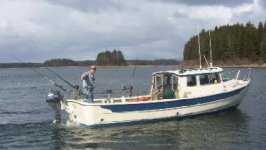The well-executed rescue by our C-brats brings up another topic. So here's Dusty's take.
Every self-bailing cockpit I've had - incuding Tomcat 24, Orca, Arima, Pierson, and others - only self bail under ideal conditions. My biggest problem with water coming back through the scuppers and flooding the cockpit is when tending shrimp pots. The boat always weather-cocks, stern to the seaway, with the shrimp pot acting as an anchor. We usually back up on the pot line to ease the strain on the puller which increases the water pressure on the transom. Too much weight aft, which lowers the scuppers, increases the problem.
The only good solution that I've found is a commercial unit which contains a small ball that seals the scupper with any backpressure present. It works! The other rubber flaps, etc., don't.
I don't know the vendor of the unit, but I can get it from Les if there is any interest. These little inexpensive gadgets would probably have saved the Bayliner which took on so much cockpit water it lost stability and flipped.
Dusty
Every self-bailing cockpit I've had - incuding Tomcat 24, Orca, Arima, Pierson, and others - only self bail under ideal conditions. My biggest problem with water coming back through the scuppers and flooding the cockpit is when tending shrimp pots. The boat always weather-cocks, stern to the seaway, with the shrimp pot acting as an anchor. We usually back up on the pot line to ease the strain on the puller which increases the water pressure on the transom. Too much weight aft, which lowers the scuppers, increases the problem.
The only good solution that I've found is a commercial unit which contains a small ball that seals the scupper with any backpressure present. It works! The other rubber flaps, etc., don't.
I don't know the vendor of the unit, but I can get it from Les if there is any interest. These little inexpensive gadgets would probably have saved the Bayliner which took on so much cockpit water it lost stability and flipped.
Dusty

